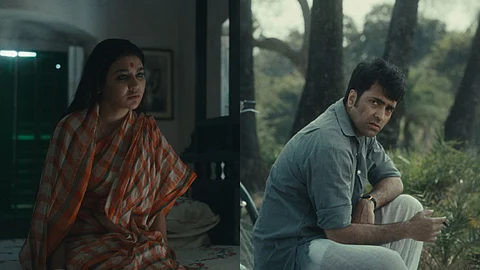
- HOMEGROWN WORLD
- #HGCREATORS
- #HGEXPLORE
- #HGVOICES
- #HGSHOP
- CAREERS
- ABOUT US
- CONTACT US

It begins with a death. On an overcast evening, an old man named Haru Ghosh is struck by lightning and dies standing under a banyan tree. This sudden, accidental death sets in motion a series of events that change the course of a man's life and the lives of an entire village.
Manik Bandopadhyay’s 'Putul Nacher Itikotha (The Puppet’s Tale, 1936)' remains one of the defining works of 20th-century Bengali literature. First serialised in the Bengali monthly literary magazine Bharatvarsha between 1934 and 1935 and published as a book in 1936, Putul Nacher Itikotha marked a clear break from the romanticism of the Bengal Renaissance, signalling the emergence of a new form of psychological and social realism in Bengali literary fiction. Beneath its seemingly simple rural setting lies a dark and complex study of human agency and vulnerability, where characters move like puppets, as if pulled by fate’s invisible strings.
Bandopadhyay, in his mid-twenties when he wrote the novel, described it as a “sympathetic protest” — a lament and an outrage against those who pull the strings of others’ lives. Using the metaphor of puppetry, he explored how individuals become trapped by social customs and traditions, caste hierarchies, economic dependency, superstitions, and subconscious desires.
Set in the fictional village of Gaudia in rural Bengal, the story revolves around Shashi, a young college-educated physician who returns home after completing his medical studies in Calcutta. He feels like both an insider and an outsider — respected by the villagers as a doctor but emotionally distant and disconnected from them, growing increasingly eager to return to the city or pursue higher studies abroad. His widowed father, Gopal, hopes he will settle down and conform to tradition, but Shashi moves through Gaudia with an increasing sense of alienation.
Kusum, Haru Ghosh’s son Paran’s wife, openly flirts with Shashi against social norms. At the same time, rumours spread about his father’s closeness to Sendidi, an emotionally disturbed woman crushed by infertility and the dullness of domestic life. Both women symbolise lives stuck in the same place, their desires silenced by social customs and traditions, and both disturb Shashi in different ways.
Among the other villagers, Shashi feels a connection with Jadav Pundit, a scholar of theology. Despite their philosophical disagreements, Shashi respects the older man’s clarity of thought and conviction in his beliefs. A shift occurs with the arrival of Kumud, Shashi’s college friend from Calcutta, who now runs a traveling jatra troupe. Kumud falls in love with Haru Ghosh’s daughter Moti, and asks Shashi to help arrange their marriage. Although Shashi agrees, he remains sceptical of Kumud’s intentions with Moti.
As the novel unfolds, these tensions escalate. Jadav Pundit cryptically declares that he will die on the day of the Ratha Yatra, triggering a frenzy among the villagers. Pilgrims and believers gather around Jadav Pundit’s home, awaiting the auspicious ending. Meanwhile, Shashi remains stuck in Gaudia as those around him either fade away or leave: Kumud and Moti elope to Calcutta; Kusum departs for her father’s home in Bajitpur; Gopal, too, eventually goes to Benares, and the village becomes marked by death and departure.
Almost a hundred years after it was first published, Putul Nacher Itikotha stands out for its modernist ambitions. Bandopadhyay uses interior monologues, fractured, non-linear timelines, and shifting narrative perspectives to explore the subconscious of his characters. The outcome is a form of psychological naturalism — gritty, intimate, and relentlessly probing. Freudian themes run beneath the surface, as repressed sexuality and irrational impulses influence the characters’ choices far more than they realise.
Yet, Putul Nacher Itikotha is also profoundly political. Bandopadhyay, influenced by Marxist theory and socialist ideas, condemns the feudal and patriarchal systems that shaped Bengali rural life in the 20th century. His commitment to social realism is relentless: there is no nostalgia for the village and no romanticized pastoralism. Instead, the village becomes a crucible of emotional and social oppression, where the illusion of autonomy is gradually taken away.
What makes Putul Nacher Itikotha such a masterpiece is Bandopadhyay’s refusal to provide neat conclusions. Everyone is compromised. Everyone dances, knowingly or not, to a tune beyond their control. In Putul Nacher Itikotha, human agency is an illusion — one that unravels under the weight of social obligation, inner conflict, and desire. Yet, by portraying this condition with such clarity and compassion, Putul Nacher Itikotha holds up a dark, shimmering mirror to both the self and society.
Putul Nacher Itikotha, a film adaptation of the novel directed by Suman Mukhopadhyay, is releasing on August 1, 2025. Learn more about the film here.
If you enjoyed reading this, here's more from Homegrown:
Santanu Bhattacharya’s Debut Novel Captures The Political Realities Of Modern India
Judge A Book: Amit Malhotra's Immersive Cover Designs Are Elevating Homegrown Novels
Aminder Dhaliwal's Graphic Novel Uses A Witch's Tale As An Allegory For Modern Burnout
